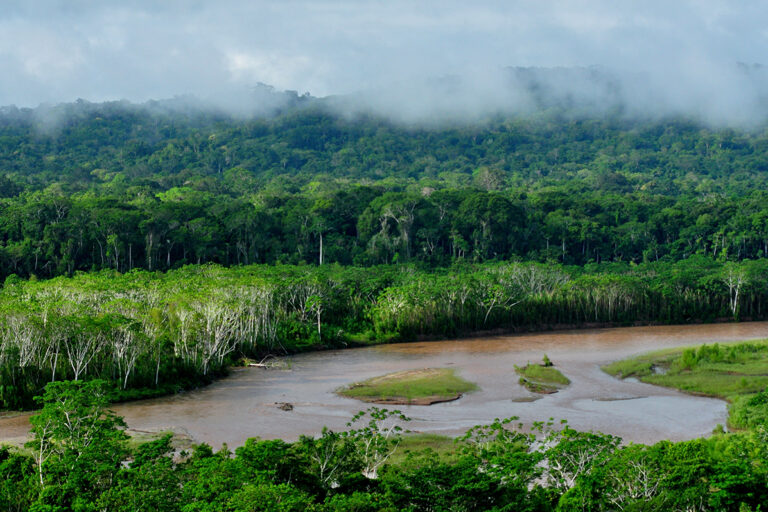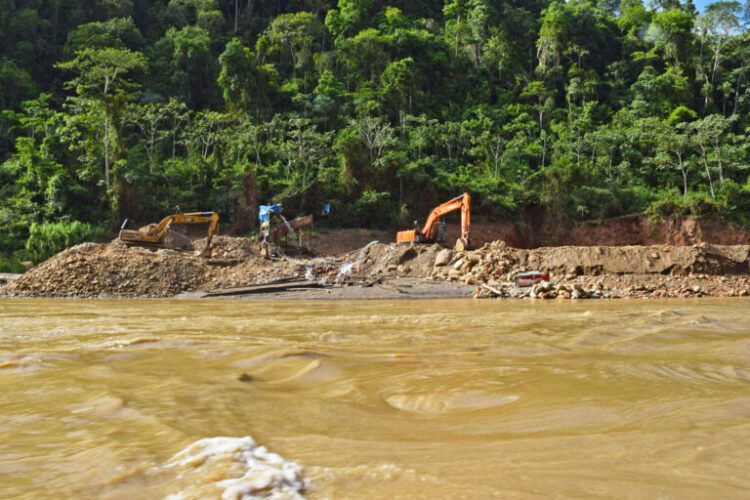Mayaya is a community near Madidi National Park. This town has become an unofficial headquarters for miners. Barrels full of diesel fuel arrive before being taken into the reserve. Image by Iván Paredes.
One of the most critical areas in Madidi is the community of Santa Cruz del Valle Ameno, in the municipality of Apolo, northern La Paz. The town is the gateway to Madidi and is the site of a park ranger control post that has been overrun by miners for the past year. The area’s residents report that several trucks enter the area every day carrying barrels of diesel to fuel the miners’ machines.
According to park ranger reports, over seven days in April of this year, 53,000 liters (14,000 gallons) of diesel entered Madidi through the Santa Cruz del Valle Ameno community. A park ranger who asked to remain anonymous told us that 6,600 liters (1,743 gallons) were destined for Santa Rosa and 46,640 liters (12,320 gallons) went to Virgen del Rosario Santa Clara, two small towns within the protected area.
Other communities affected by illegal mining are Azariamas and Suyo Suyo, two areas in the heart of the reserve. Edgar Villca is part of the local branch of Control Social, an organization made up of communities and trade unions working to protect their territories and represents the populations within Madidi and other protected areas. Villca explains that mining activity has now come to a stand-still in the two communities, but that the miners’ machinery remains.
On the banks of the Tuichi River, however, the situation has worsened. Several mining cooperative camps have been set up, operating illegally and preventing park rangers from accessing the area by means of roadblocks. Many of the park rangers have been threatened and removed from the areas they protect. It was not until March of this year that the National Protected Areas Service (SERNAP) took legal action to stop the illegal activities and began to remove the machinery. SERNAP, which reports to Bolivia’s ministry of environment and water, states that it will continue to carry out controls not only in Madidi but in all protected areas.

“I know that they were operating in some communities in Madidi — for that, they need both an environmental license and a permit from SERNAP. They didn’t have them, and instead they were using papers from the Jurisdictional Administrative Mining Authority (AJAM), but we have no idea whether these were official or falsified. We take the necessary steps to stop their activity and to remove them, but they do not comply. There is no official presence in the area, and little or nothing can be done,” explained a park ranger who asked to remain anonymous.
AJAM claims it has not issued any permits to mining cooperatives to operate in Madidi or Apolo. Moreover, AJAM says it “condemns” these illegal activities. “AJAM reiterates its commitment to the preservation of the environment and natural resources, through a transparent strategy and in compliance with our responsibilities,” reads part of the statement the organization sent to Mongabay Latam.
Splitting Madidi in two
Senator Requena also accuses the mining cooperatives of creating roads inside the national park and in other nearby protected areas. “The worst thing is that a road already exists between Pelechuco and Apolo — they just want to save a few hours by passing through the national park. This deserves special attention from an environmental standpoint, and we should not be encouraging unnecessary roads.”
Despite Senator Requena’s objections, the road is being backed by the La Paz government, and is costing 7.2 million Bolivianos (just over $1 million). The road will also affect the Apolobamba Integrated Management Natural Area, which borders Madidi.
According to the local government in La Paz, the 120-kilometer-long (74.5-mile-long) road project is intended to “connect potential areas for agriculture, livestock, mining and tourism with the rest of the country.”
Alex Villca, spokesperson for CONTIOCAP, says this new highway is part of the Initiative for the Integration of Regional Infrastructure in South America (IIRSA), a project involving 12 South American countries to physically link their transportation, telecommunications and energy infrastructures, with the aim of promoting sustainable development in the region. Villca says this initiative is designed to facilitate the “plundering” of natural resources in Madidi and Apolobamba, such as gold, timber, and wild animals.
“This road is intended to support extractive mining. Chinese and Colombian companies are already in our rivers, and then other nationalities will follow. Little by little they are taking over our lands, and that means they will control protected areas and Indigenous territories. The resources they take will not even stay in the country,” he warns.
According to Yordi Calle, Director of the La Paz Departmental Road Service (SEDCAM), the National Service of Protected Areas (SERNAP) has approved a pre-investment study for this project in a strict protection zone. “SERNAP says it has granted permission for a pre-investment study in a designated area, so it is also committed to assisting SEDCAM and the consulting firm,” said Calle.
Park rangers at risk
The fact that Madidi is a national park has not prevented miners from entering the area, even going so far as to drive out its park rangers. Raúl Santa Cruz, a ranger who has worked to protect Madidi for 20 years, reports that on March 30, 2023, he was told that a group of people with heavy mining machinery was trying to enter via Virgen de Rosario, a community inside the park on the banks of the Tuichi River. Eight park guards went to the control post, and at around 1 p.m., backhoes and dump trucks began to arrive.
Later that day at 7 p.m., Ramiro Cuevas, who runs the Virgen del Rosario cooperative, arrived and asked if he could enter the protected area with heavy machinery. His request was denied because he did not have any permits. “As head of protection, I informed him (Cuevas) that in order to undertake any construction work, he must have an environmental permit and approval. Ramiro did not like that at all and said some bad things to me, using derogatory words. He threatened me, got up from his seat and came towards me to attack me,” says Santa Cruz.
At 1:00 a.m. on March 24, 2023, following pressure and threats, the group managed to enter Madidi with their machinery. “We couldn’t do anything; there were too many people and we were afraid,” says Santa Cruz.
However, in a statement presented by Cuevas to the La Paz Public Prosecutor’s Office, the miner begins by saying that he is not in the mining business, and that he does not own a cooperative in the north of the La Paz department. In a letter sent to environmental leaders who support Santa Cruz, he explained, “I stepped out of my vehicle to ask them to give way to private vehicles, a request that was also made by several others affected by the roadblock. But I never requested access for heavy machinery.”
Ramiro Cuevas also stated that he is a farmer and that his family’s livelihood depends on this activity. However, on the Facebook page for Agenda Minera, a local media outlet focused on mining issues, in 2021, Cuevas actively discussed the resumption of mining activity following the pandemic. He has also been vocal about the possibility of storming the Madidi Park offices to protest against Marcos Uzquiano, a former park ranger and a strong opponent of mining in the protected area.
Raúl Santa Cruz says he has been through an ordeal. He was attacked, intimidated, and even faced criminal charges brought against him by Cuevas for defamation in March 2023. A month ago, he successfully won the lawsuit, but he is saddened that Madidi has not been able to free itself from illegal mining.
The same lawsuit was filed against Marcos Uzquiano, president of Bolivia’s Association of Conservation Agents (ABOLAC), who merely expressed his solidarity with Santa Cruz through his social media networks. Uzquiano was also cleared of any wrongdoing.
According to Santa Cruz, it is now “very difficult” to work in Madidi. He says there are even areas where they simply cannot enter, because roadblocks have been put in place to prevent park rangers from checking the site. He is also disappointed that some of Madidi’s Indigenous community leaders have turned to illegal mining, which makes monitoring some areas of the national park much more difficult.
SERNAP director Johnson Jiménez told Mongabay Latam that his organization protects the park rangers in their work. In order to make their work easier, in May, the organization began installing satellite antennas to provide internet access, ensuring the rangers can have direct contact with SERNAP. Jiménez says five antennas have been installed in several protected areas, one of them in Madidi.
“The new satellite service will be a beneficial tool for communication in our five protected areas. For us, this takes us another step closer to sustainably developing our country and our protected areas,” said Jiménez.
According to SERNAP, these satellite antennas will make the monitoring of protected areas more effective. In addition, they will be used for communication, efficient coordination and technical management reports in emergency situations, with all stakeholders responsible for protecting the reserves, and with the Indigenous peoples as their corresponding authorities.
“In the communities there are roadblocks, making it difficult to enter even inside the park [Madidi] — they do not allow us to carry out our duties. The problem is that the community leaders agree with the mining representatives, saying that we are harming development. We can access the sites, but then they put conditions on us, they tell us what we can and can’t do during the inspections where mining activity is taking place,” claims Santa Cruz.
Despite the uncertainties, a thread of hope still runs through Madidi. There are still community members who are willing to defend their lands and work with SERNAP. Park ranger Francisco Pana tells us that, in April this year, a barrier was constructed next to the community of San José de Uchupiamonas, in the middle of the reserve, to protect the park from miners.
But Pana says this is a light-touch measure. He is calling for more support and more park guards. Madidi only has 12 guards in the central zone, and a total of 26 for the entire natural area. This makes their work difficult, he says.
Pana suggests setting up ecotourism projects, which he believes could be a last-ditch attempt to protect Madidi and prevent illegal mining.
Banner image: Illegal mining is spreading in the Amazonian rivers that enter the Madidi National Park in Bolivia. Dredges are installed in these tributaries to remove sediment from river bottoms. Image by Iván Paredes Tamayo
Rapid growth of Bolivia’s lithium industry creating new problems for local communities
Source link : http://www.bing.com/news/apiclick.aspx?ref=FexRss&aid=&tid=66bf852486f64019ab90fbf051f7bb6e&url=https%3A%2F%2Fnews.mongabay.com%2F2024%2F08%2Fa-national-park-and-its-rangers-in-bolivia-endure-persisting-road-construction-illegal-mining%2F&c=9628850553598338421&mkt=en-us
Author :
Publish date : 2024-08-15 13:00:00
Copyright for syndicated content belongs to the linked Source.
